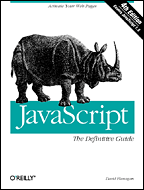WebReference.com - Chapter 17 of JavaScript: The Definitive Guide (4th Ed), from O'Reilly & Associates (1/15)
[next] |
JavaScript: The Definitive Guide (4th Ed)

Chapter 17: The Document Object Model
The series of excerpts below are from Chapter 17 of the O'Reilly & Associates title, JavaScript: The Definitive Guide (4th Edition).
A document object model (DOM) is an application programming
interface (API) for representing a document (such as an HTML document) and accessing and manipulating
the various elements (such as HTML tags and strings of text) that make up that document. JavaScript-enabled
web browsers have always defined a document object model; a web-browser DOM may specify, for example,
that the forms in an HTML document are accessible through the forms[]
array of the Document object.
In this chapter, we'll discuss the W3C DOM, a standard document object model defined by the World Wide Web Consortium and implemented (at least partially) by Netscape 6 and Internet Explorer 5 and 6. This DOM standard[1] is a full-featured superset of the traditional web-browser DOM. It represents HTML (and XML) documents in a tree structure and defines properties and methods for traversing the tree and examining and modifying its nodes. Other portions of the standard specify techniques for defining event handlers for the nodes of a document, working with the style sheets of a document, and manipulating contiguous ranges of a document.
This chapter begins with an overview of the DOM standard and then describes the core portions of the standard for working with HTML documents. The discussion of the core standard is followed by short sections that explain the DOM-like features of Internet Explorer 4 and Netscape 4. The chapter ends with an overview of two optional parts of the DOM standard that are closely related to the core. Later chapters cover advanced DOM features for working with style sheets and events.
1.Technically, the W3C issues "recommendations." These recommendations serve the same purpose and carry the same weight as international standards do, however, and are called "standards" in this book.
[next] |
Created: November 28, 2001
Revised: November 28, 2001
URL: https://webreference.com/programming/javascript/definitive/chap17/


 Find a programming school near you
Find a programming school near you